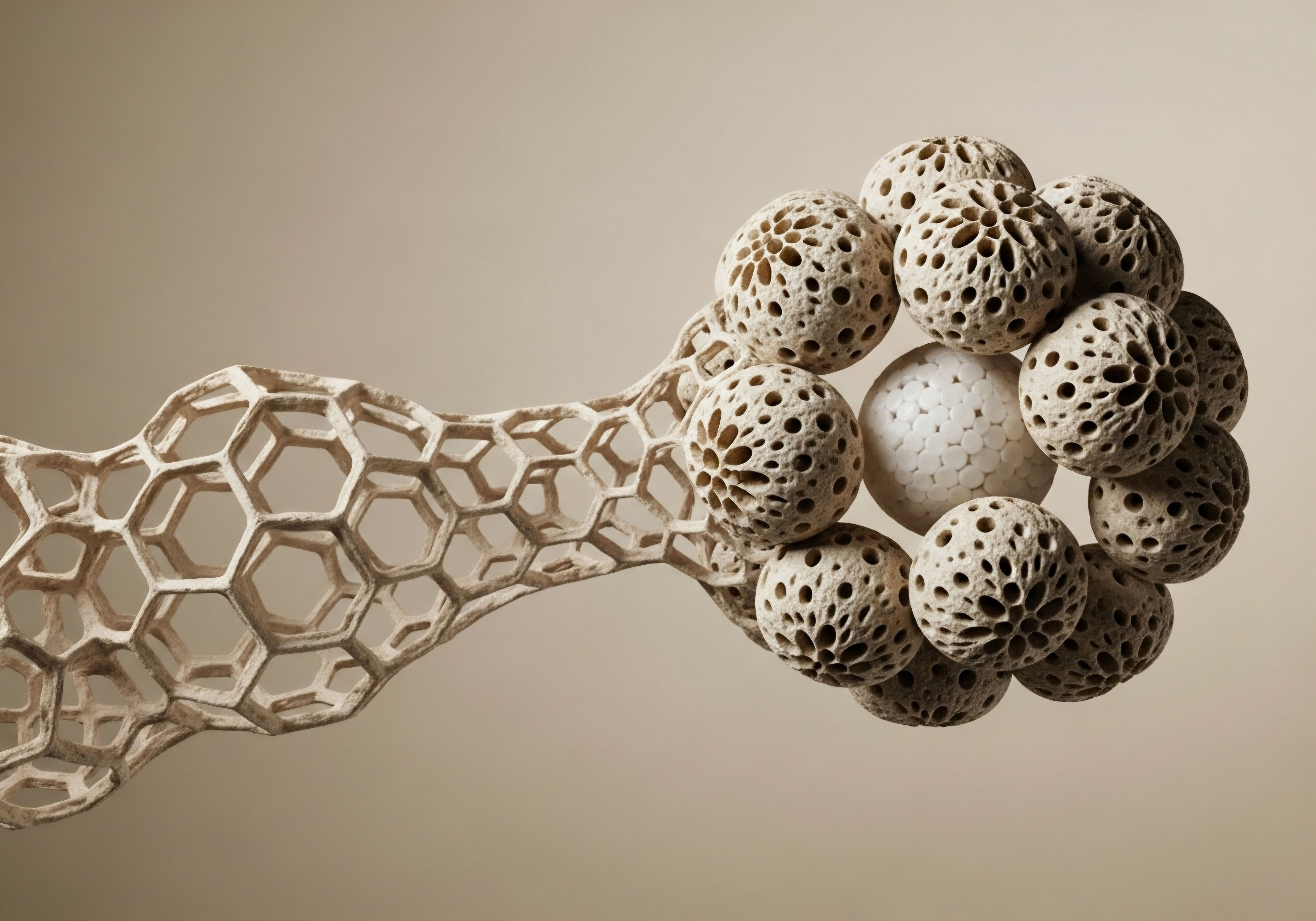

Fundamentals
The experience of feeling disconnected from one’s own vitality, grappling with unexplained shifts in mood, energy, or physical capacity, often prompts a search for answers. Many individuals attribute these changes to the inevitable march of time, a natural diminishment of vigor with advancing years.
Yet, these sensations frequently signal a deeper biological narrative unfolding within the body, a story written in the intricate language of biochemical messengers. Understanding these signals, particularly those emanating from the endocrine system, represents a powerful step toward reclaiming well-being and function. This journey of comprehension begins with recognizing that the body’s internal communication network, orchestrated by hormones, profoundly influences every aspect of daily existence.
Hormones, often conceptualized as mere chemical agents, function as the body’s internal messaging service, transmitting vital instructions from one region to another. These molecular couriers are synthesized and released by specialized tissues, primarily glands, directly into the circulatory system. Once circulating, hormones seek out specific target cells equipped with compatible receptors, much like a key fitting into a precise lock.
This highly specific interaction ensures that even though hormones travel throughout the entire organism, their directives are received and acted upon only by the intended cellular recipients. The sheer number of these chemical signals, exceeding fifty distinct types, underscores their pervasive influence on nearly all physiological processes, from metabolic regulation to reproductive function, and even the subtle rhythms of sleep and emotional balance.
The collective of these hormone-producing glands and their intricate feedback loops constitutes the endocrine system. This system operates as a sophisticated regulatory network, continuously monitoring and adjusting hormone levels to maintain internal stability, a state known as homeostasis.
Key components of this remarkable system include the pituitary gland, often termed the “master gland” due to its control over many other endocrine tissues; the thyroid, which governs metabolic rate; the adrenal glands, responsible for stress response; and the gonads, which produce sex steroids.
The pancreas, while also playing a role in digestion, secretes insulin and glucagon, hormones essential for blood sugar control. Even adipose tissue, commonly known as body fat, contributes to this complex symphony by releasing hormones such as leptin and adiponectin, influencing metabolism and energy balance.
A central organizing principle within this system is the concept of biological axes, which describe the hierarchical relationships between different glands. The Hypothalamic-Pituitary-Gonadal (HPG) axis serves as a prime example, orchestrating reproductive health and influencing aging. This axis begins in the hypothalamus, a region at the base of the brain, which releases gonadotropin-releasing hormone (GnRH).
GnRH then stimulates the pituitary gland to secrete two crucial hormones ∞ luteinizing hormone (LH) and follicle-stimulating hormone (FSH). These gonadotropins, in turn, act upon the gonads ∞ the testes in males and the ovaries in females ∞ to stimulate the production of sex steroids, including testosterone, estrogen, and progesterone. This intricate chain of command, regulated by both positive and negative feedback mechanisms, ensures that hormone levels remain within a healthy physiological range, adapting to the body’s changing needs throughout life stages.
The body’s internal communication, driven by hormones, profoundly shapes our daily experience and overall vitality.
The question, “Is Hormone Therapy Just for Women?”, arises from a common, yet incomplete, understanding of these biological systems. Historically, discussions surrounding hormonal support often centered on female experiences, particularly menopause. However, the scientific understanding of endocrine function reveals that hormonal shifts are a universal aspect of the human condition, affecting individuals across all biological sexes and life stages.
Declining hormone levels, whether of testosterone in men, or estrogen and progesterone in women, can lead to a spectrum of symptoms that diminish quality of life. These symptoms are not merely isolated complaints; they are often outward manifestations of underlying biochemical imbalances that can impact physical energy, emotional equilibrium, cognitive sharpness, and metabolic efficiency.
Recognizing that hormonal health extends beyond a single gender or life event opens the door to a more comprehensive approach to well-being. The principles of biochemical recalibration apply broadly, seeking to restore optimal physiological function by addressing specific hormonal deficiencies or imbalances.
This involves a precise evaluation of an individual’s unique hormonal profile, considering their symptoms, lifestyle, and measurable biomarkers. The aim is not to simply replace what is missing, but to optimize the body’s internal environment, allowing for a return to a state of greater vitality and functional capacity. This perspective acknowledges the personal journey of each individual, validating their lived experience while providing a clear, evidence-based pathway toward improved health.


Intermediate
Moving beyond foundational concepts, a deeper exploration of hormonal optimization protocols reveals tailored strategies for distinct physiological needs. The application of hormonal optimization protocols extends to both male and female physiology, addressing specific imbalances with precision. These interventions are designed to recalibrate endocrine function, alleviating symptoms and enhancing overall well-being. Understanding the ‘how’ and ‘why’ behind these therapies requires a closer look at the specific agents employed and their targeted actions within the body’s complex signaling networks.

Male Hormone Optimization Protocols
For men experiencing symptoms associated with declining testosterone levels, often termed andropause or low testosterone (low T), Testosterone Replacement Therapy (TRT) represents a primary intervention. This condition, characterized by reduced libido, diminished energy, loss of muscle mass, and mood changes, can significantly impact daily life.
A standard approach involves the administration of Testosterone Cypionate, typically via weekly intramuscular injections at doses ranging from 50-100mg, or 100-200mg every two weeks. The goal is to restore circulating testosterone to a mid-normal range, generally between 500-700 ng/dL, which correlates with symptomatic improvement.
Maintaining the delicate balance of the endocrine system during TRT often involves additional therapeutic agents. One such compound is Gonadorelin, a synthetic analog of gonadotropin-releasing hormone (GnRH). Administered typically via subcutaneous injections twice weekly, Gonadorelin stimulates the pituitary gland to release luteinizing hormone (LH) and follicle-stimulating hormone (FSH).
This action helps to preserve the body’s natural testosterone production and maintain testicular size and fertility, which can be suppressed by exogenous testosterone administration. This is particularly relevant for younger men who wish to retain their reproductive potential.
Another important consideration in male hormonal recalibration is the management of estrogen levels. Testosterone can convert into estrogen through a process called aromatization. Elevated estrogen can lead to undesirable effects such as gynecomastia (breast tissue development) and fluid retention. To counteract this, an aromatase inhibitor like Anastrozole may be prescribed, typically as an oral tablet twice weekly.
This medication works by blocking the enzyme aromatase, thereby reducing the conversion of testosterone to estrogen and helping to maintain a balanced hormonal profile. Careful monitoring of estrogen levels is essential to ensure optimal balance and prevent excessive suppression, which can also lead to adverse effects.
For men concerned about fertility while on TRT, or those seeking to stimulate endogenous testosterone production without exogenous administration, Enclomiphene offers a valuable option. This selective estrogen receptor modulator (SERM) acts by blocking estrogen receptors in the hypothalamus, which in turn signals the pituitary to increase LH and FSH secretion. This cascade stimulates the testes to produce more testosterone and sperm, making it a suitable choice for addressing hypogonadism while supporting reproductive function.

Female Hormone Balance Protocols
For women, hormonal balance protocols address a range of symptoms associated with hormonal changes, particularly during peri-menopause and post-menopause. These symptoms can include irregular cycles, mood fluctuations, hot flashes, and diminished libido. While estrogen and progesterone are primary considerations, testosterone also plays a significant role in female well-being, often overlooked. Women naturally produce testosterone, and its levels decline with age or following surgical removal of the ovaries.
In female hormonal support, Testosterone Cypionate is typically administered in very low doses, often 10 ∞ 20 units (0.1 ∞ 0.2ml) weekly via subcutaneous injection. This targeted supplementation can improve sexual function, including desire, arousal, and orgasm, and may also enhance mood, cognitive function, energy, and bone density.
Progesterone is a crucial component of female hormonal support, especially for women who still have their uterus. Estrogen therapy alone can cause the uterine lining to thicken, increasing the risk of endometrial hyperplasia and, potentially, endometrial cancer. Progesterone counteracts this effect, protecting the uterine lining.
It is prescribed based on menopausal status and individual needs, available in various forms including oral micronized progesterone, patches, injections, or vaginal gels. Beyond endometrial protection, progesterone can alleviate symptoms such as heavy uterine bleeding, hot flashes, night sweats, and sleep disturbances.
An alternative delivery method for testosterone in women is pellet therapy. This involves the subcutaneous insertion of small, rice-sized pellets, typically in the hip or buttocks, which gradually release hormones over three to five months. This method provides consistent, physiological levels of testosterone, bypassing the liver and avoiding large fluctuations seen with other administration routes.
While offering benefits for a range of menopausal symptoms, it is important to note that compounded hormone pellets are not FDA-approved, and some concerns exist regarding unpredictable levels and removal difficulty.

Growth Hormone Peptide Therapy
Beyond traditional sex steroid replacement, growth hormone peptide therapy offers a distinct avenue for biochemical recalibration, particularly for active adults and athletes seeking anti-aging benefits, muscle gain, fat loss, and improved sleep. These peptides function as growth hormone secretagogues, stimulating the body’s natural production and release of growth hormone (GH) from the pituitary gland, rather than directly introducing synthetic GH.
Key peptides in this category include ∞
- Sermorelin ∞ A synthetic analog of growth hormone-releasing hormone (GHRH), it stimulates the pituitary to release GH in a pulsatile, physiological manner.
- Ipamorelin / CJC-1295 ∞ Ipamorelin is a selective growth hormone secretagogue that increases GH levels with minimal impact on cortisol.
CJC-1295, a GHRH analog, works synergistically with Ipamorelin to provide a sustained increase in GH and IGF-1 levels, promoting muscle growth and fat metabolism.
- Tesamorelin ∞ This GHRH analog is specifically approved for reducing excess abdominal fat in HIV-associated lipodystrophy.
It stimulates GH and IGF-1, leading to a reduction in visceral fat and improvements in lean body mass.
- Hexarelin ∞ A potent GHRP that mimics ghrelin, stimulating GH release. It also exhibits cardioprotective and anti-inflammatory effects independent of GH, acting directly on cardiac receptors.
- MK-677 (Ibutamoren) ∞ An orally active, non-peptide ghrelin mimetic that stimulates sustained increases in GH and IGF-1. It is explored for muscle mass enhancement, bone density improvement, and sleep quality, without suppressing endogenous hormone production.
These peptides represent a sophisticated approach to optimizing growth hormone pathways, leveraging the body’s inherent mechanisms for rejuvenation and performance enhancement.

Other Targeted Peptides
The realm of peptide therapy extends to highly specific applications, addressing particular physiological needs ∞
- PT-141 (Bremelanotide) ∞ This synthetic peptide is a melanocortin receptor agonist that acts centrally on the brain to stimulate sexual arousal pathways.
It is approved for hypoactive sexual desire disorder (HSDD) in premenopausal women and is used off-label for erectile dysfunction in men, offering a unique mechanism distinct from vascular-acting medications.
- Pentadeca Arginate (PDA) ∞ A synthetic peptide similar to BPC-157, enhanced for stability. PDA is gaining recognition for its regenerative and anti-inflammatory properties. It promotes tissue repair, collagen synthesis, and reduces inflammation, showing promise in accelerating wound healing, improving gut health, and supporting muscle recovery.
These targeted peptides exemplify the precision available in modern biochemical recalibration, offering solutions that address specific physiological challenges with a high degree of specificity.
Personalized hormonal support for men and women involves precise agents like testosterone, progesterone, and growth hormone peptides, each with specific actions.
The selection and dosage of any hormonal agent or peptide must be highly individualized, based on comprehensive laboratory assessments, a thorough review of symptoms, and an understanding of personal health goals. This tailored approach ensures that interventions align with the body’s unique biological blueprint, promoting optimal outcomes and supporting a sustained state of well-being.


Academic
To truly comprehend the breadth of hormonal influence and the rationale behind personalized wellness protocols, one must delve into the intricate cellular and systemic mechanisms that govern endocrine function. The body’s internal regulatory systems are not isolated entities; rather, they operate as an interconnected web, where alterations in one pathway can ripple across multiple physiological domains. This systems-biology perspective reveals how hormonal balance, or its disruption, profoundly impacts metabolic function, cellular signaling, and even neurocognitive processes.

The Hypothalamic-Pituitary-Gonadal Axis and Metabolic Interplay
The Hypothalamic-Pituitary-Gonadal (HPG) axis, a central regulator of reproductive health, also maintains a dynamic interplay with metabolic pathways. The hypothalamus, positioned at the brain’s base, secretes gonadotropin-releasing hormone (GnRH) in a pulsatile fashion. This neurohormone travels to the anterior pituitary, stimulating the release of luteinizing hormone (LH) and follicle-stimulating hormone (FSH).
These gonadotropins then act on the gonads ∞ the testes in males and ovaries in females ∞ to produce sex steroids such as testosterone, estrogen, and progesterone. This feedback loop is essential for reproductive development, function, and aging.
Beyond reproduction, the HPG axis interacts extensively with other crucial neuroendocrine axes, including the Hypothalamic-Pituitary-Adrenal (HPA) axis, which governs stress response, and the Hypothalamic-Pituitary-Thyroid (HPT) axis, which regulates metabolism. For instance, chronic stress, by activating the HPA axis and elevating glucocorticoid levels (like cortisol), can directly suppress GnRH release, thereby inhibiting the HPG axis and leading to reproductive dysfunction. Conversely, gonadal steroids can modulate HPA axis activity, illustrating a bidirectional regulatory relationship.
Metabolic health is inextricably linked to HPG axis function. Dysregulation within this axis can contribute to conditions such as insulin resistance and type 2 diabetes. Sex steroids, particularly testosterone and estrogen, influence glucose metabolism, lipid profiles, and body composition.
For example, low testosterone in men is often associated with increased visceral adiposity and insulin resistance, while estrogen plays a protective role in female metabolic health, influencing fat distribution and insulin sensitivity. Understanding these complex interactions is paramount for a holistic approach to metabolic and hormonal well-being.

Cellular Signaling and Receptor Dynamics
At the cellular level, hormones exert their effects through highly specific interactions with hormone receptors. These receptors are specialized protein molecules located either on the cell surface or within the cell’s interior. The nature of the hormone dictates its receptor location.
Peptide hormones, being water-soluble and unable to cross the lipid bilayer of the cell membrane, bind to cell surface receptors. This binding initiates a cascade of intracellular events, often involving second messengers like cyclic AMP (cAMP), which then transmit the signal deeper into the cell, leading to rapid, short-term changes in cellular activity. Examples include insulin, growth hormone, and various pituitary hormones.
In contrast, steroid hormones (e.g. testosterone, estrogen, progesterone) are lipid-soluble, allowing them to diffuse directly across the cell membrane. Once inside the target cell, they bind to intracellular receptors, typically located in the cytoplasm or nucleus. This hormone-receptor complex then translocates to the nucleus, where it directly interacts with specific DNA sequences called hormone response elements (HREs).
This interaction modulates gene transcription, leading to the synthesis of new proteins and eliciting slower, but more sustained, changes in cellular function and structure.
The sensitivity of a cell to a particular hormone is not static; it can be modulated by the number of available receptors. Up-regulation refers to an increase in receptor numbers in response to low hormone levels, enhancing cellular sensitivity. Conversely, down-regulation involves a decrease in receptor numbers when hormone levels are high, reducing cellular responsiveness. This dynamic regulation ensures precise control over physiological responses, even with minute concentrations of circulating hormones.

Advanced Therapeutic Agents and Their Mechanisms
The development of advanced therapeutic agents, including specific peptides, represents a sophisticated application of these cellular and systemic understandings.
Consider the growth hormone secretagogues ∞
- Tesamorelin, a synthetic GHRH analog, specifically targets the pituitary gland’s somatotroph cells. It mimics endogenous GHRH, stimulating the pulsatile release of growth hormone (GH) and subsequent insulin-like growth factor 1 (IGF-1) production from the liver.
This mechanism is particularly effective in reducing visceral adipose tissue in conditions like HIV-associated lipodystrophy, by promoting lipolysis and influencing metabolic pathways.
- Hexarelin, a hexapeptide, operates by activating the growth hormone secretagogue receptor (GHSR), which is distinct from the GHRH receptor.
While it stimulates GH release, its cardioprotective effects appear to be mediated by direct binding to cardiac receptors, including GHSR 1a and CD36, independent of GH. This suggests a broader pharmacological profile, influencing cardiac function and inflammation through direct cellular interactions.
- MK-677 (Ibutamoren), a non-peptide compound, also acts as a ghrelin mimetic, binding to the GHSR-1a receptor.
Its oral bioavailability and long half-life allow for sustained elevation of GH and IGF-1 levels without disrupting the body’s natural pulsatile release patterns or suppressing the HPG axis. This makes it a compelling agent for enhancing lean body mass, improving bone mineral density, and optimizing sleep architecture by influencing GH-related neurological pathways.
The precision of these peptides, acting on specific receptors and signaling pathways, underscores the potential for highly targeted biochemical recalibration. For instance, PT-141 (Bremelanotide), a melanocortin receptor agonist, bypasses vascular mechanisms to directly influence central nervous system pathways associated with sexual desire and arousal. Its action on MC3R and MC4R receptors in the hypothalamus and arcuate nucleus highlights the direct neurological modulation of physiological responses.
Similarly, Pentadeca Arginate (PDA), a modified form of BPC-157, exemplifies regenerative medicine at a molecular level. Its enhanced stability and bioavailability allow it to promote tissue regeneration, collagen synthesis, and reduce inflammation. Research indicates its role in stimulating angiogenesis (new blood vessel formation) and modulating growth factors, which are critical for wound healing and tissue repair. The ability of PDA to regulate inflammation by assisting the body’s repair processes at a faster pace speaks to its sophisticated biological influence.
Hormones act through specific receptors, initiating complex cellular cascades that impact metabolism, growth, and function.
The intricate web of hormonal feedback loops, receptor-ligand interactions, and downstream signaling pathways reveals a profound biological intelligence. Understanding these deep-level processes allows for the development of personalized wellness protocols that move beyond symptomatic relief to address the root causes of physiological imbalance. This scientific rigor, combined with an empathetic understanding of the individual’s experience, forms the bedrock of effective and empowering health interventions.

References
- Cleveland Clinic. Endocrine System ∞ What It Is, Function, Organs & Diseases.
- US EPA. Overview of the Endocrine System.
- OpenStax. Anatomy & Physiology. 17.1 An Overview of the Endocrine System.
- Johns Hopkins Medicine. Anatomy of the Endocrine System.
- Wikipedia. Endocrine system.
- Rani Anbarasu MD PA. Differences Between Men’s and Women’s Hormone Therapies.
- Woodlands OBGYN Associates. How Is Hormone Replacement Therapy Different for Women & Men.
- Victory Men’s Health. Hormone Replacement Therapy for Men vs. Women.
- Dr.Oracle. What is the recommended protocol for Testosterone Replacement Therapy (TRT) in patients with hypogonadism?
- Joint Trust Guideline for the Adult Testosterone Replacement and Monitoring.
- PMC. Evolution of Guidelines for Testosterone Replacement Therapy.
- Endocrine Society. Testosterone Therapy for Hypogonadism Guideline Resources.
- UHCprovider.com. Testosterone Replacement or Supplementation Therapy ∞ Commercial Medical Benefit Drug Policy.
- PMC. Should we be prescribing testosterone to perimenopausal and menopausal women? A guide to prescribing testosterone for women in primary care.
- Australasian Menopause Society. Testosterone use in women.
- Right Decision Service. Testosterone replacement in menopausal women (Guidelines).
- Taylor & Francis Online. Testosterone replacement in menopause.
- Global Consensus Position Statement on the Use of Testosterone Therapy for Women.
- Empower Pharmacy. Compounded Gonadorelin in Men’s Health.
- TRT Preserve Pack.
- Excel Male TRT Forum. Beginner, TRT with Anastrozole and Enclomiphene.
- NovaGenix. Enclomiphene for men on TRT.
- PMC. Progesterone in Peri- and Postmenopause ∞ A Review.
- Everlywell. Benefits of Taking Progesterone After Menopause.
- My Menoplan. Hormone Therapy (estrogen/progesterone).
- CeMCOR. Progesterone Therapy for Menopause.
- Taylor & Francis Online. Progesterone for treatment of symptomatic menopausal women.
- Swing Women’s Health & Wellness. Testosterone Pellet Therapy in Metairie, LA.
- testosterone implant dosing women.
- Women’s Wellness Center. Bioidentical Hormone Pellet Therapy for Women.
- CAM 019. Implantable Hormone Pellets for Females.
- Medical News Today. Hormone pellet therapy ∞ Procedure, benefits, and safety.
- DrugBank Online. Tesamorelin ∞ Uses, Interactions, Mechanism of Action.
- Patsnap Synapse. What is the mechanism of Tesamorelin Acetate?
- Innerbody Research. Tesamorelin Peptide | Benefits, Safety, & Buying Advice.
- RxList. Egrifta (Tesamorelin Injection) ∞ Side Effects, Uses, Dosage, Interactions, Warnings.
- Wikipedia. Tesamorelin.
- Revolution Health & Wellness. Unlocking the Power of Hexarelin ∞ The Ultimate Guide to This Game-Changing Peptide.
- Medical Anti-Aging. MAA-Hexarelin.docx.
- Oxford Academic. Growth Hormone Secretagogue Hexarelin Stimulates the Hypothalamo-Pituitary-Adrenal Axis via Arginine Vasopressin.
- PubMed. Mechanism of action of Hexarelin. I. Growth hormone-releasing activity in the rat.
- PMC. The cardiovascular action of hexarelin.
- Revolution Health & Wellness. Peptide Therapy – MK-677.
- TeleTest.ca. Side Effects and Risks of MK-677.
- Swolverine. MK-677 (Ibutamoren) Cycle ∞ The Ultimate Guide to Growth, Recovery, and.
- Wikipedia. Ibutamoren.
- Rupa Health. MK 677 ∞ Your Ultimate Ibutamoren Resource.
- Wikipedia. Hypothalamic ∞ pituitary ∞ gonadal axis.
- UK Biobank. Multidimensional Phenotypic Associations of Hypothalamic-Pituitary Activity Beyond the HPG Axis.
- PubMed Central. Emerging insights into Hypothalamic-pituitary-gonadal (HPG) axis regulation and interaction with stress signaling.
- Number Analytics. HPG Axis and Reproductive Health ∞ A Deep Dive.
- MDPI. Metabolic Regulation by the Hypothalamic Neuropeptide, Gonadotropin-Inhibitory Hormone at Both the Central and Peripheral Levels.
- StudySmarter. Hormone Receptor Signaling ∞ Explained & Pathways.
- Wikipedia. Hormone receptor.
- BC Open Textbooks. 18.2 How Hormones Work ∞ Concepts of Biology.
- Taylor & Francis eBooks. Hormone and Receptor Interactions in Cell Signaling.
- JoVE. Endocrine Signaling ∞ Mechanism | Biology | Video.

Reflection
Having explored the intricate landscape of hormonal health, from foundational biological principles to advanced therapeutic interventions, a central understanding emerges ∞ your body possesses an extraordinary capacity for self-regulation and restoration. The information presented here is not merely a collection of facts; it represents a framework for understanding your own biological systems, empowering you to engage with your health journey from a position of informed agency.
The symptoms you experience are not random occurrences; they are often meaningful signals from your internal environment, guiding you toward areas that require attention and support.
This exploration into the interconnectedness of the endocrine system, its influence on metabolic function, and the precision of personalized biochemical recalibration protocols serves as a starting point. It is an invitation to consider your own vitality and functional capacity not as fixed states, but as dynamic expressions of your unique biological blueprint. The path to reclaiming optimal health is a personal one, requiring careful consideration of individual needs, comprehensive assessment, and a partnership with knowledgeable healthcare professionals.
Consider how the concepts discussed might relate to your own experiences. Do the descriptions of hormonal shifts resonate with changes you have observed in your energy, mood, or physical performance? Reflect on the idea that supporting your endocrine system can unlock a renewed sense of well-being. This knowledge is a powerful tool, enabling you to ask more precise questions, seek more targeted solutions, and ultimately, to pursue a life of sustained vitality without compromise.



